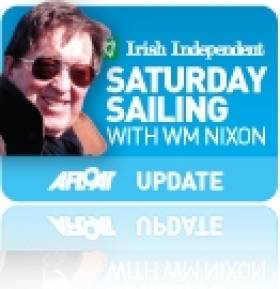Displaying items by tag: Hamilton Island
America's Cup. From Isle of Wight to Hamilton Island
#americascup – If the 36th America's Cup is staged at Hamilton Island, it will continue a long story, started from the Isle of Wight in 1851. W M Nixon introduces this exotic venue, then ponders the ultimate seaworthiness of multihulls.
We signed off here on this sailing blog a fortnight ago with the admission that the sacredly monstrous America's Cup in its new form for the 34th Edition has got us hooked, as indicated by our own and general global interest in that key question: "What happens next?" That was Saturday September 28th. We didn't have long to wait. On Monday September 30th, it was announced that Hamilton Island Yacht Club of Australia has been accepted by cup holders Golden Gate Yacht Club as the Challenger of Record for the 35th America's Cup.
Hamilton what? Where island? Is it somewhere comparable to the Isle of Wight, where it all started way back in 1851 with the race round the island for the Hundred Guineas Cup? For once, we were ahead of the posse without having to go to google. Back in 2007, Gordon Maguire was signed up as lead helmsman on Mike Slade's 100ft Leopard for a serious tilt at the Fastnet Race record. But that was the year that the start was postponed for 25 hours because of a Force 9 sou'wester. And Maguire's window of opportunity to do the Fastnet was very narrow, as he was contracted to be at some event called Hamilton Island Race Week to skipper Matt Allen's Ichi Ban immediately afterwards.
He took a look at the new schedules, and reckoned the Fastnet start delay ruled him out, and flew out for Australia. But Leopard still broke the record. Yet all we can really remember about it now is it was the year Ger O'Rourke's Chieftain was Fastnet Race overall winner, and that this Hamilton Island place with its race week must have something very special going for it.
Five years down the line, it's more special than ever. Hamilton Island is owned by veteran campaigner Bob Oatley, a serial entrepreneur whose sailing credentials have been firmly established with a long string of boats called Wild Oats, with his current hundred footer Wild Oats XI holding the Sydney-Hobart Race record. Hamilton Island resort is one of his pet projects. For some of us, the fact that the daytime temperature seldom goes below 26 degrees is a distinct drawback, but others will think it paradise. It's among the Whitsunday Islands on the Great Barrier Reef coast of Queensland, and the Australian distances are enormous – you're talking about a dozen hours of steady driving north from Brisbane.
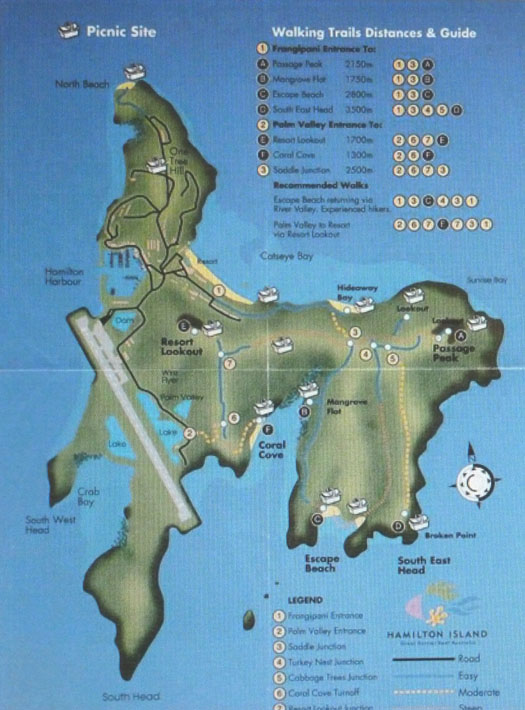
Every America's Cup location should have at least one picnic site. Hamilton Island has all the facilities for the big one
Thus everybody hopes to fly there, as it has its own airport where the runway comes in one side of the island, and goes out the other. It's right beside the harbour, thus it's possible to get sailing immediately to avoid having the temperature floor you. And if you're minded to sail round the island to celebrate getting there, it shouldn't take too long, as Hamilton Island is just three miles long by two miles wide, though it's so indented with bays that it's only two square miles in all, about twice the size of Lambay.
That said, as it's among the coral of the Great Barrier Reef, not all the sailing around Hamilton Island is as straightforward as getting round Lambay. For even if you avoid Plum Pudding Reef and Fitzalan Reef and Hamilton Island Reef itself, and then keep clear of Perseverance Reef and Young Island Reef, there's still Surprise Rock Reef waiting to...well, surprise you.
But the word is the yacht club is very fully appointed, and just itching to host the America's Cup eight years down the line. However, what form the America's Cup will be eight years hence is anyone's guess, and currently it's open season in the global comment and criticism stakes, with advocates of multi-hulls in a defiant "We told you so" frame of mind as the world of sailing grudgingly admits that the 72ft foiling catamarans in the 34th America's Cup brought the thing to life.
Instinctive multi-hull resistance is nothing new. The Polynesians and other Pacific islanders may have been merrily trundling around their nice warm ocean for centuries on multihulls of all types, but attempts to transfer the concept to colder waters failed to do the business for many years. Way back in 1663, that extraordinary polymath William Petty, the man who created the Down Survey which tabulated Ireland, tested his own-designed catamaran Simon & Jude (which he'd had built in Dublin) in the Liffey and on Dublin Bay, and the new machine out-sailed a ship's gig and a "pleasure boatte" of renowned performance. The Simon & Jude was re-created for Hal Sisk by master shipwright John O'Reilly in Dublin in 1991, and a race was staged with one of the Bantry Boats and a little Dutch cutter enthusiastically playing the roles of the opposition, but the S & J outsailed them both.
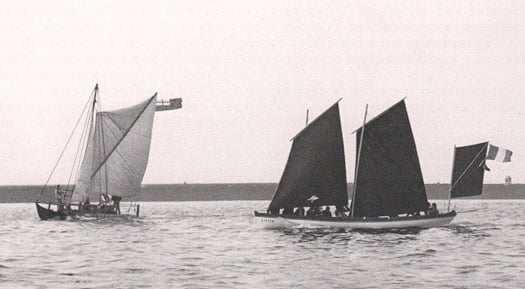
Ireland's first multi-hull, the Simon & Jude of 1663, was re-created by Hal Sisk in 1991 to re-stage her initial race when she comfortably outsailed a ship's gig, re-enacted here by one of the Bantry boats. Photo: W M Nixon
However, the concept soon came up against the ultimate seaworthiness trial after Petty built The Experiment, a much larger catamaran with accommodation. She certainly outsailed the Dublin-Holyhead packet boat by a significant amount, but failed to return from a test venture into the Bay of Biscay, and the old salts happily stuck with their traditional mono-hull craft.
In subsequent centuries the idea arose again from time to time, and in 1870 a Belfast amateur sailor, John MacKenzie, created the 21ft Jumelle, with a twin hulls of sufficiently modern appearance to make the classic 1870s gaff cutter rig fitted to her seem bizarre. By all accounts she could sail well in a straight line – speeds of ten knots were reported – but despite it being a time when yachting was developing rapidly, the people spending the money were notably conservative, and the Belfast Lough yachting establishment stayed determinedly with their mono-hulled cutters, schooners, ketches and yawls.
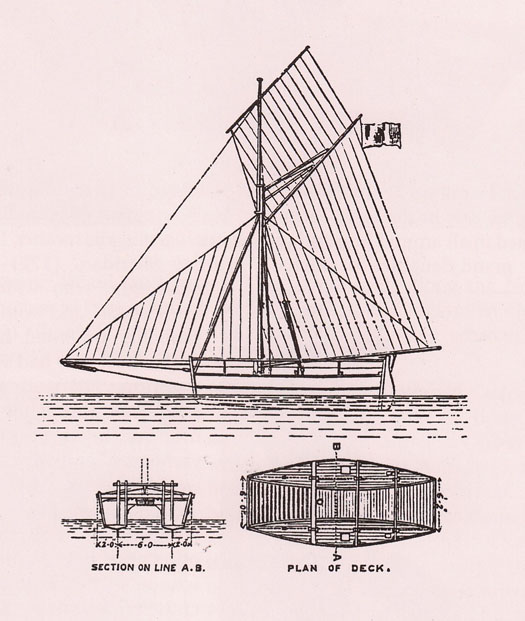
John MacKenzie of Belfast designed and built the 21ft catamaran Jumelle in 1870, and achieved speeds of 10 knots.
This conservatism was also found in America. When the 28-year-old designer Nathanael Herreshoff turned up with his new catamaran Amaryllis for the American Centennial Regatta at Staten Island in 1876 and won in very convincing style, catamarans were promptly banned from all future events. But in truth it was only with the development of lighter building methods and more advanced engineering that multihulls could really show their full potential, and it wasn't until the 1960s with innovators such as the late great Dick Newick that serious offshore racing multihulls finally began to gain traction.
Let's face it, we'd all love multihulls and would happily tear about the seas with them, if two very fundamental problems could be solved. Firstly, how do you find a berth for them when they're twice the area of monohulls of similar size, and sometimes aren't the best at manoeuvring in confined space. And secondly, how can you get round the fact that they are even more stable upside down than they are right way up, and are completely lacking in the mono-hull's self-righting ability?
Putting these problems aside for the moment, there are some very attractive cruising multihulls, and for some time – particularly before I got hip and knee replacements when boats heeling over used to be a pain – I fancied, and still do, the Dragonfly range built in Denmark. We've something of an inside track on the Dragonfly 920 as two of the Howth diaspora, Johnny Malcolm and Black Bob Fannin, crew with Roland Sharp who has his Dragonfly 920 Ischnura based in the Thames Estuary, and they have now and again speeded round to Cowes to do the Round the Island Race with quite a modicum of success.

The Danish-built trimaran Dragonfly 920 is one of Europe's most successful multihull performance cruisers
In 2011 they won the multihull division, and last year they came second. That race of 2012 was memorable, as Ben Ainslie was helming the mighty Eleanor, the re-creation of the legendary Westward, the 135ft Herreshoff schooner of 1910 vintage. This awesome vessel started in the early morning before the multihulls, slugging westward down the Solent in majestic style, but the cheeky little Ischnura was past her before the Needles despite breaking a jib sheet which cost her the win in her class, but she still was a good second.
This gives a hint of the Dragonfly's performance potential. She was hitting 15 to 20 knots comfortably round the back of the island, and having started at 0600, they'd finished the 50-mile circuit course by 1130. Ischnura is the version known as the Dragonfly 920 EX (which is Extreme if you really want to know), but though she's optimised for performance with extra sail area, she still has the advantage of being based around a single central hull which can be utilised to provide much better accommodation than a catamaran of the same 30ft size, for it's said that you need to go to 40ft or even 50ft before you can start putting decent accommodation in a catamaran.
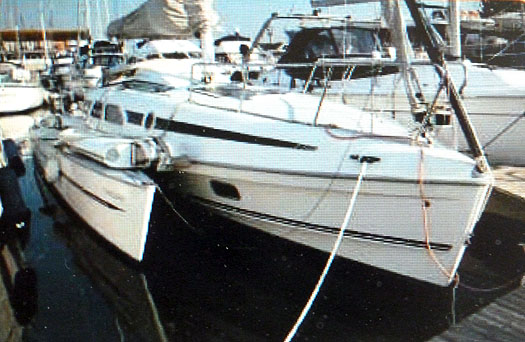
Berthing problems solved. The Dragonfly can fold her wings.
Thanks to swing wings, the Dragonfly range can halve their beam to come into a marina berth. The builders claim it can all be done from the cockpit taking a minute for each side, which is probably rather faster than the raising of the bowsprit by a gaffer in order to reduce overall length for berthing purposes. So with beam reduced and a light overall weight, the Dragonfly is also a proposition for easy trailing. In all, an attractive package, but building light and strong is expensive, as is providing the engineering for the swing wings, so it has to be faced that an almost-new Dragonfly 920EX sold recently for €142,000, which you can compare at your leisure with boats of similar accommodation, and reach your own conclusions.
But putting the price aside, and having dealt with the berthing problem, what's the situation regarding scary sailing? This week's vid of Jeanne-Pierre Dick's MOD 70 capsizing is a reminder of the ultimate vulnerability of multihulls, but in sailing Ischnura in a wide variety of situations, Johnny Malcolm says he has never felt cause for alarm, while the enjoyment factor as she ramps up the speed is fantastic. But he did mention that he wasn't aboard when Roland Sharp and Black Bob Fannin were tearing past the North Foreland in wind over tide and carrying the spinnaker in rather more wind than they should, and they did have a megafright, but lived to tell the tale.
But following the capsize of a Dragonfly 28 in the Round the Island race, the boat's enthusiasts – and they are many – simply stated that it's a fact of life: if you drive any trimaran too hard, you're going to capsize. However, it's when multi-hulls are sitting becalmed and get hit by a sudden gust that their ultimately non-self-righting characteristics can become unexpectedly evident. In the more mountainous parts of Scotland's West Coast, where the hills are high but the waters narrow, multihulls have had their problems. One of the most squally places is Loch Scathvaig, which thrusts deep into the Cuilins of Skye. A Dragonfly 28 sitting totally becalmed here was reported pitch-poled by a katabatic blast, and the water being deep, went completely upside down.
You don't need to be right under the heights of the Cuilins in order to experience sudden gusts of real power. Just round the corner and up the southeast coast of Skye along the Sound of Sleat is Isle Ornsay, a lovely spot whose only disadvantage is that when the wind is from the east, it can come storming across the Sound big time out of the brooding mountains of Loch Hourn, and sudden easterly squalls seemingly out of nowhere are another Hourn treat.
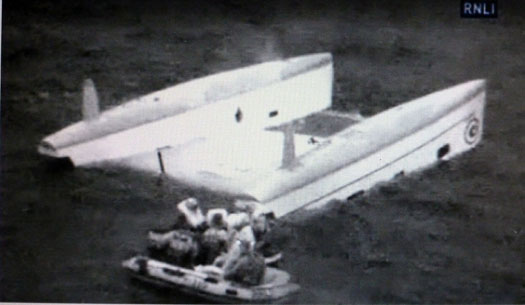
Horrid end to a lovely day.....the new Pampero TS52 is flippd by a sudden squall in the Sound of Sleat, 1st August 2012
In 2012, a big new French cruising catamaran, a 52ft Pampero TS, was sitting flat becalmed off Isle Ornsay. The name of the marque proved an unfortunate choice. A Loch Hourn pampero squall arrived with a bang. Before she could get moving to improve sail carrying power, and before anyone could get to the mainsheet, she was upside down.
Everyone was taken off safely, and within days an ace Isle Ornsay team led by Pete Fowler had righted her and brought her into Mallaig. We happened to call by that fine port a few days later on our way back from the Outer Hebrides, and as our skipper Dickie Gomes used to be a multhull ace with the 40ft Northern Ireland-built Newick trimaran Downtown Flyer (we'll return to that story another day), we were interested to hear his views on the big salvaged boat in the quayside yard.
My word, she was big. Enormous. The mast alone was like a round tower or a minaret. And with everything on the boat and about her, there was a feeling of the suddenness of it all, the total upset to a pleasant day. We came upon two or three salt-stained playing cards scattered in the cockpit. The vision of a sophisticated French charter party leisurely playing cards with highly intellectual conversation and then – zap – came irresistibly to mind. The imagination was enough. Even our skipper, seldom at a loss for words, had little to say.
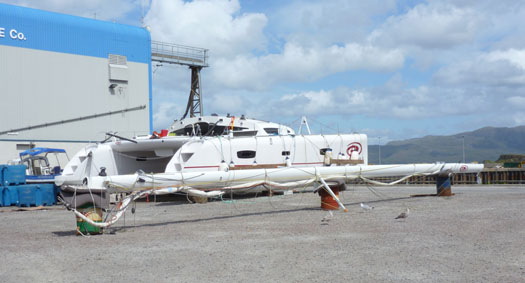
At first glance the salvaged catamaran in Mallaig seemed to show few signs of her capsize.......Photo: W M Nixon
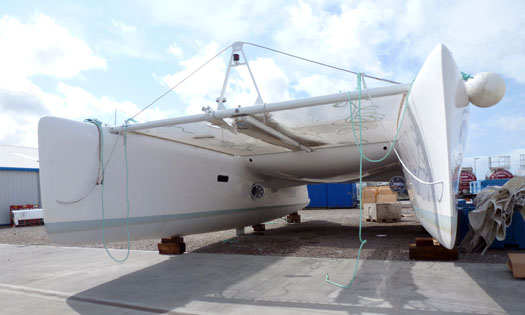
...and gave all the impressions of being a powerful fast cruiser....Photo: W M Nixon

....but soon the evidence could be discerned....Photo: W M Nixon
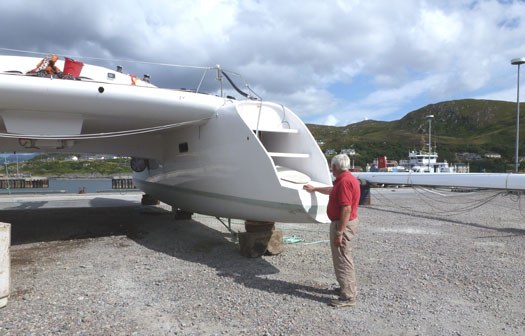
...and then everywhere we found signs of sudden catastrophe. Photo: W M Nixon
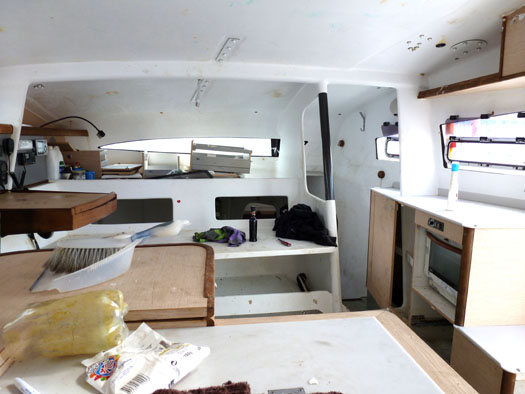
It was clear how spacious and stylish the big saloon had been....Photo: W M Nixon
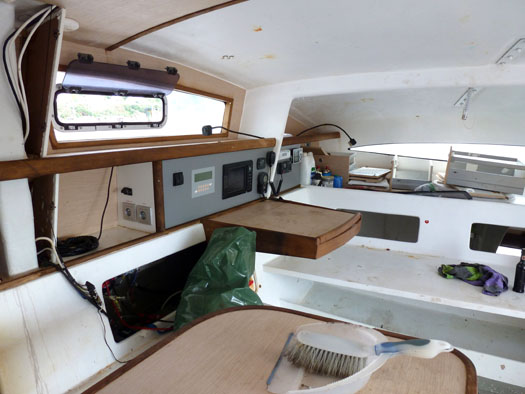
.....with its stylishly planned layout now damaged by oil and water Photo: W M Nixon

Our skipper, formerly a very determined offshore multihull racer, was for once lost for words. Photo: W M Nixon
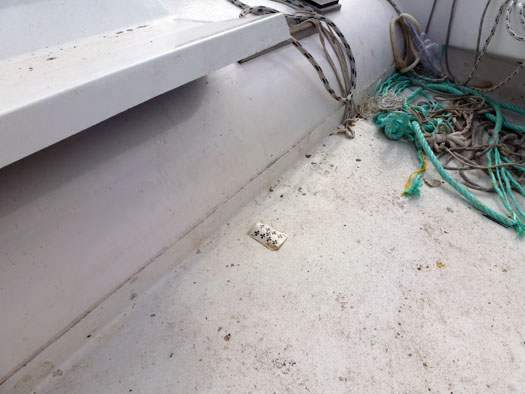
It was easy to imagine how peaceful things had been before the squall struck. The charter party may even have been playing a game of cards in the cockpit......Photo: W M Nixon
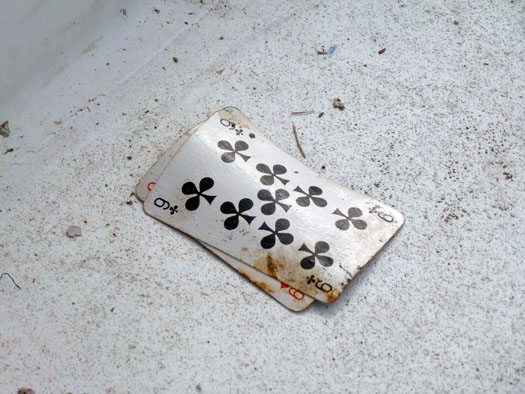
A pity. It had the makings of a good hand. Photo: W M Nixon
So even the big expensive multihulls have this ultimate drawback. There's no way around it, offshore multihulls should carry a health warning. But the rewards of living with the risk are fantastic sailing, and an ability to eat up the miles on passage in a style which leaves much larger craft in the ha'penny place.
The fact that it's decidedly different from orthodox sailing is all part of the package in making the America's Cup excitingly exotic. It needs multi-hulls, and it needs a bit of size. They talk of making them more affordable in order to attract more teams o the next series. But "more affordable" suggests smaller. Surely they couldn't be think of going below 60ft? And no doubt when the bubbles have settled a bit, some bright spark will say that the only way to maintain the excitement is to make the next generation 90ft.
Whatever, it's a long way over 162 years from the Isle of Wight to Hamilton Island. And it's a long way from he robust ocean-crossing schooner America to the extraordinary machines that captured global imagination in September. What happens next?


























